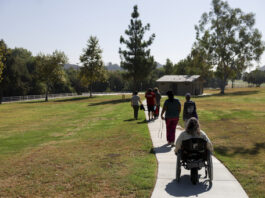WASHINGTON (AP) — In declining to step aside from two high-profile Supreme Court cases, Justice Samuel Alito on Wednesday provided a rare window on the opaque process by which justices decide to step aside from cases.
Alito faced calls from Democrats to recuse from two cases involving former President Donald Trump and Jan. 6 defendants because of the controversy over flags that flew over his homes.
Both flags were like those carried by rioters who violently stormed the Capitol in January 2021 while echoing Trump’s false claims of election fraud.
Revelations about the flags came as the court is considering cases related to the Jan. 6 riot, including charges faced by the rioters and whether Trump has immunity from prosecution on election interference charges.
In letters to members of Congress, Alito said he had no involvement in flying an upside-down flag over his home in 2021 and an “Appeal to Heaven” flag at his New Jersey beach house last year. He said his wife, Martha-Ann, was responsible for both flags. His impartiality, he said, could not reasonably be questioned.
The explanation is unlikely to satisfy Democratic critics, but they have little recourse.
A look at the Supreme Court’s recusal process:
THERE OUGHT TO BE A LAW
There is, as well as a recently adopted Supreme Court ethics code to guide the justices, though there’s really no means of enforcing either.
A law that applies to Supreme Court justices and all other federal judges lays out several criteria that require recusal.
The language most relevant in Alito’s case reads, “Any justice, judge, or magistrate judge of the United States shall disqualify himself in any proceeding in which his impartiality might reasonably be questioned.”
The court’s code of conduct says a justice ordinarily has a duty to take part in cases since justices, unlike lower-court judges, can’t be replaced when there’s a conflict. The code differs from the federal law by saying a justice “should,” rather than “shall,” disqualify himself or herself. It also says that only an impartial and reasonable person who is “aware of all relevant circumstances” can validly call for recusal.
WHO DECIDES?
Supreme Court justices decide for themselves whether and when to recuse from a case. On rare occasions, a party to a case will ask a justice to recuse.
In one notable example, the Sierra Club asked Justice Antonin Scalia to recuse from a 2004 case about an energy task force convened by then-Vice President Dick Cheney after reports that Scalia and Cheney, old friends, went duck-hunting together.
Scalia spent 21 pages explaining his decision not to recuse, acknowledging that he accepted an invitation to fly to a Louisiana hunting camp on Cheney’s government plane, but denying that they actually hunted or spent any significant time together.
“If it is reasonable to think that a Supreme Court justice can be bought so cheap, the nation is in deeper trouble than I had imagined,” Scalia wrote.
“Since I do not believe my impartiality can reasonably be questioned, I do not think it would be proper for me to recuse,” he wrote.
Ultimately, the only consequence for a justice’s refusal to recuse is also a highly unlikely one: impeachment by the House of Representatives and removal from office by the Senate. That’s never happened.
ALITO’S EXPLANATION
Alito pointed to the Supreme Court’s ethics code to explain that justices have an obligation to take part in a case unless their impartiality might reasonably be questioned. In this instance, he said, anyone “not motivated by political or ideological considerations or a desire to affect the outcome of Supreme Court cases” would see that recusal is not required.
The justice wrote that in both instances, the flags were flown by his wife and were not hoisted to identify with Capitol rioters or the “Stop the Steal Movement.” Alito said he was unaware of the “Appeal to Heaven” flag’s association with the effort to undo the 2020 election results. In 2021, he said he urged his wife to take down the inverted U.S. flag, but she refused for several days.
Alito defended his wife’s right to her express herself and also detailed some of the sacrifices she has made because of his Supreme Court service, “including the insult of having to endure numerous, loud, obscene, and personally insulting protests in front of our home that continue to this day and now threaten to escalate.”
DO JUSTICES EVER RECUSE?
Yes, it happens all the time. Most recently, Justice Brett Kavanaugh noted his recusal from the court’s rejection Tuesday of lawyer Michael Avenatti’s appeal of his criminal conviction for attempting to extort up to $25 million from Nike. Although Kavanaugh didn’t say why, it seems likely that he sat out the case because Avenatti represented one of the women who accused Kavanaugh, during his Supreme Court confirmation hearings, of sexual misconduct. Kavanaugh has denied any impropriety.
Other examples are when justices, including Alito, hold even a tiny investment in a company with a case before the court. Last year, Alito didn’t take part in an appeal involving Phillips 66. He didn’t explain his decision, but his financial disclosure showed he owns between $15,000 and $50,000 in company stock.
One other common reason for recusal is when justices have dealt with cases in previous jobs, either in the executive branch or as lower-court judges. Last week, Justice Ketanji Brown Jackson and Kavanaugh recused from a case involving former Guantanamo detainee Omar Khadr, whose case had previously been before the federal appeals court in Washington on which Jackson and Kavanaugh both served. Jackson noted the reason for her recusal, but Kavanaugh didn’t.
This website uses cookies so that we can provide you with the best user experience possible. Cookie information is stored in your browser and performs functions such as recognising you when you return to our website and helping our team to understand which sections of the website you find most interesting and useful.
